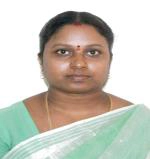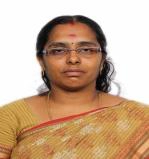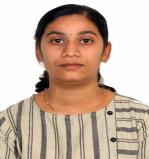Centre for Functional Materials (CFM)
Investigation on nucleation kinetics, growth and characterization of Urea phthalic acid and Urea adipic acid third order NLO single crystals
Date of presentation: 16-02-2022 | Timings: 11:30 AM to 12:30 PM | Name of the Speaker: Ms. R. Dhivya
Abstract
Nucleation and growth kinetics give information about the crystal growth process, which can be utilized in the growth of large size crystals. Urea phthalic acid (UPA) and Urea adipic acid was synthesized by slow evaporation method. Solubility was analysed gravimetrically and it is observed that it exhibits positive temperature coefficient of solubility which is suitable for bulk growth. Metastable zone width and induction period was observed. UPA was synthesized and subsequently grown by slow cooling technique. The crystal system and lattice parameters were confirmed by single X-ray diffraction analysis. Fourier transform infrared (FT-IR) analysis was performed to identify the functional groups and their corresponding assignment. The cut off wavelength of the grown crystal was 238 nm and band gap energy was found to be 3.5eV from UV-vis-NIR spectrum. The mechanical stability of the grown crystal was estimated by Vickers micro-hardness studies. The dielectric constant and dielectric loss were studied as a function of various frequencies at different temperatures.
About Speaker

Ms. R. DHIVYA is an internal full time research scholars at centre for functional materials, Vellore Institute of Technology, Vellore. Ms. Dhivya has carried out her research work on synthesis and characterization of NLO single crystals. Today, she gave presentation on “Investigation on Nucleation kinetics, growth and Characterization of urea based dicarboxylic acid ferroelectric and third order NLO single crystals” and she explained non-linear property, the mechanism in generating second harmonic and third harmonic generation. She explained the synthesis of urea based dicarboxylic acid NLO single crystals.
Cross-Linked Pva-Ca Polymer Electrolyte For Proton Conducting Fuel Cell Applications
Date of presentation: 23-02-2022 | Timings: 11:30 AM to 12:30 PM | Name of the Speaker: Ms. S Gurulakshmi
Abstract
In this study, fabrication and ionic conduction of PVA-CA-NH4SCN polymer electrolyte membranes modified by Glutaraldehyde as a cross-linker has been discussed. In order to study the effect of cross-linker, membranes with different glutaraldehyde content have been prepared by the solution casting method. The properties of these membranes were studied in detail by FT-IR, TGA, DSC, XRD, UTM and AC impedance analysis. The peak performance observed from the single Fuel cell assembly for our membrane PVA/CA/NH4SCN/4%GA is 0.24 mW/cm2 and current density of 15 mA/cm2. The cross-linked membrane displays good mechanical stability, insolubility along with desirable proton conduction which suggests these membranes are suitable for electrochemical applications
About Speaker

Mrs. S. Gurulakshmi is working as an Assistant professor in Guru Nanak College, Chennai and pursuing her PhD degree in SAS, VIT in the field of solid-state Ionics. She did her master’s degree in Physics at Alagappa University Karaikudi. During her M.Phil, she carried out the research work on “Growth and characterization of Mn doped Bi2212 superconducting material”. She has completed state eligibility test (SET) for the lectureship. Currently she is working in polymer electrolytes for Proton exchange membrane Fuel cells under the guidance of Dr. S. Madeswaran.
Structural, optical, mechanical, dielectric and nonlinear optical studies of Rubidium hydrogen oxalate dihydrate (RbC4H7O10) single crystal
Date of presentation: 30-03-2022 | Timings: 11:30 AM to 12:30 PM | Name of the Speaker: Ms. D.S. Ajisha
Speaker 1
Abstract
A transparent Rubidium hydrogen oxalate dihydrate (RbHOH) single crystal was synthesized by adopting the slow solvent evaporation method. RbHOH crystallizes in the triclinic structure with the space group. The characteristic FTIR spectrum reflects the vibrational modes of water molecules and hydroxyl groups present in the material. From the absorption spectrum, the lower cutoff wavelength of RbHOH was observed at 260 nm with an energy gap of 4.7 eV. From TG/DSC, the thermal stability of RbHOH was found to be around 91°C. The normal indentation size effect of the material was verified with the help of Vickers microhardness analysis. Dielectric properties as a function of frequency have been studied over a wide range of temperatures. The third-order nonlinear susceptibility of RbHOH was calculated to be 3.95242×10-6 esu.
About Speaker

Ajisha D.S has been a research scholar in the School of Advanced Sciences, Vellore Institute of Technology (VIT) Vellore, since 2015 and is associated with the center for functional materials. Her research area includes crystal growth, characterization of single growth crystal. She has published papers in reputed international journals and conferences. Earlier, she served as an assistant professor in a reputed engineering institute for a decade and received awards for her teaching excellence. She has attended number of workshops and faculty development Programmes
Luminescence, Non Linear Optical and Fluoride ion Sensing Studies of Ferrocene/Non-Ferrocene Conjugated Borasiloxanes and Ferrocenyl Push-Pull Chromophores
Date of presentation: 30-03-2022 | Timings: 11:30 AM to 12:30 PM | Name of the Speaker: Mr.T. Viswanathan
Speaker 2
Abstract
The development of new organometallic material with push-pull systems has been utilized in various nonlinear optical applications such as electro-optic modulators, optical data storage devices, telecommunications, optical switches and NLO bioimaging. Synthesis and structural properties of borasiloxanes were well established. Nevertheless, not much consideration has been compensated toward the photophysical properties, and varying substituents on the boron atom can tune the absorption and emission properties of borasiloxanes. The three-coordinated boron is isoelectronic and isostructural with a positively charged carbocation, and the pz orbital of the boron atom acts as an effective π-electron acceptor. Tri- and tetracoordinated boron complexes finds applications in various functional materials.
About Speaker

Mr. Viswanathan T is doing a Ph.D., at VIT University, katpadi, Vellore. Currently, he is CSIR-SRF fellow (2020-2022) and doing research in the field of nonlinear optics (NLO). He completed his master’s degree at PSG college of arts and sciences affiliated with Bharathiar University, Coimbatore. During his master’s degree, he completed a project on thiosemicarbazone ligand for corrosion studies in acid medium.
Ferrocene/non-ferrocene conjugated Bora siloxanes for luminescence and Non-linear Optical studies
Date of presentation: 30-03-2022 | Timings: 11:30 AM to 12:30 PM | Name of the Speaker: Ms. D.S. Ajisha
Abstract
The development of new organometallic material with push-pull systems has been utilized in various nonlinear optical applications. Synthesis and structural properties of borasiloxanes were well established. Tri- and tetracoordinated boron complexes have found applications in various fields. The talk discuss on the bulk second-order nonlinear optical properties (χ2) of chromophores were carried out by Kurtz and Perry powder method and also, the first hyperpolarizabilities (β) were measured using Hyper Rayleigh scattering (HRS) technique.
About Speaker

Mr. S. Prabu is doing Ph.D., at VIT, Vellore. Currently, he is CSIR-SRF fellow and doing research in the field of nonlinear optics. He completed his M. Sc at PSG College of arts and sciences, Coimbatore. During his master’s degree, he completed a project on thiosemicarbazone ligand for corrosion studies in acid medium.
Double perovskite Material for Magnetocaloric effect Application
Date of presentation: 29-07-2022 | Timings: 04:00 PM to 05:00 PM | Name of the Speaker: Mr. P. Sathishkumar
Abstract
Double perovskite are becoming an important research topic due to its intriguing magnetic properties coupled with electric fields. As the focus for discovering new energy materials which as renewable in nature has taken a speed, the rare earth manganites possess most of the qualities to become a new energy material for cooling purpose. The magnetocaloric effect exhibited by these materials finds application in many energy devices such as refrigerator, cooler etc. The double perovskite structure of rare earth manganites helps in attaining the goal of becoming successful magnetic refrigerant. In this work, R2NiMnO6(R2= La,Gd) was synthesized using solid state reaction method. The La2NiMnO6 and Gd2NiMnO6 materials were studied for their structural, magnetic and magnetocaloric properties.
About Speaker

Mr. P.Sathishkumar completed his Master of Science in Physics from Nandha Arts and Science College, Erode, TamilNadu. During his M.Sc, he carried out his research work on Radiation survelliance in Radiotherapy”. He did his Master of Philosophy in Physics from Bharathidasan University, Thiruchirappalli, TamilNadu. During his M.Phil, he carried out his research work on Synthesis, Characterization and magnetic properties of CuFe2O4 nanoparticle”. And also, he was a Scientific Assistant of powder XRD Instrumentation at IIT Madras from 2013 to 2015 and at VIT from 2015
Formation of Air Stable Fe88Co12 Alloy Nanoparticle Prepared by High Energy Ball Milling
Date of presentation: 12-08-2022 | Timings: 04:00 PM to 05:00 PM | Name of the Speaker: Ms. P. Saraswathi
Abstract
The mechanical alloying procedure used to manufacture nanostructured materials has been a major focus in recent years. Fe88Co12 alloys are useful in a variety of fields, including magnetic storage and composite permanent magnets. Because of their unique magnetic properties, such as high permeability and higher saturation magnetization per volume than any other material, Fe88Co12 alloys are an important soft magnetic material. The goal of this investigation is to use a high-energy alloying process in air to study the effect of make a nanocrystalline Fe88Co12 alloy presenting the evolution of microstructure and magnetic properties over different milling times (0, 3, 6, 12 and 24 h) without using special equipment for sample storage or handling.
About Speaker

Ms P. Saraswathi did her Master of Science in Physics from Government Arts and Science College, Tiruvannamalai (2016-2018). She carried out her research on “Growth and characterization of boric acid doped potassium hydrogen phthalate (khpba) single crystal” during her masters. She is pursuing her PhD. as an Internal Full Time Research Scholar (IFT) under the guidance of Dr. S. Madeswaran, Associate Professor, Centre for Functional Materials (CFM), Vellore Institute of Technology, Vellore. Her topic of research is “Rare earth free hard magnetic materials”. She aims to develop a new generation of rare-earth free permanent magnets using non-rare earth metal alloys and thin films of high energy product (BHmax) for energy and data storage applications.
Ferrocene appended D-π-A Chromophores: Structure, Electrochemical, Photophysical and AIE studies
Date of presentation: 26-08-2022 | Timings: 04:00 PM to 05:00 PM | Name of the Speaker: Ms. Subiksha V S
Abstract
The D-π-A based organometallic materials has been developed due to its broad application in the field of Non-linear optics. In that pathway, Ferrocene attached 1,3-indanedione push pull chromophores has been synthesized and characterized with various analytical and spectroscopic techniques. The single crystal X-Ray diffraction study was used to confirm the structure of the chromophores. The photophysical studies were carried out and the solvatochromic studies is used to detect the charge transfer ability and Aggregation Induced Emission (AIE) studies were used to enhance the fluorescence intensity due to the mechanism of restricted intramolecular rotation by increasing the water fraction from 0-90%.
About Speaker

Ms. SUBIKSHA V S is doing a Ph.D., under the guidance of Dr. Palanisami N, Professor, Centre for Functional Materials, VIT University, Vellore. She has carried out her research work in the field of Non-linear optics. She has completed her master’s degree at PSGR Krishnammal College for Women. During her master’s degree, she has completed NPTEL course on inorganic chemistry conducted by IIT, Kharagpur.
Synthesis And Characterization Of Graphene Oxide Modified Lead-Free Magneto-Electric Composite For High- Frequency Applications
Date of presentation:16-09-2022 | Timings: 04:00 PM to 05:00 PM | Name of the Speaker: Mr. Chinmay Chandan Parhi
Abstract
Graphene oxide-modified magneto-electric composite consisting of cobalt nickel ferrite (CNF) and barium zirconium titanate (BZT) is successfully synthesized by the conventional ceramic method using the microwave sintering technique. X-Ray diffraction reveals the structural parameters of ceramic composite and a Scanning Electron Microscope (SEM) reveals the microstructural attributes of graphene oxide modified composites. UV spectroscopy and Fourier transform Infrared spectroscopy are used to estimate the band gap energy and bond vibrational stretching of the composites. It assists in understanding the effects of graphene oxide (GO) doping on the optical properties of the composite. The graphene oxide modification decreases the band gap energy of composites. Dielectric properties of magneto-electric composites are measured using an impedance analyzer and magnetic properties of composites are estimated using VSM studies.
About Speaker

Mr. CHINMAY is doing Ph.D., under the guidance of Dr. MADHURI W., Associate Professor, Centre for Functional Materials, VIT University, Vellore. He has carried out his research work in the field of multiferroics and magnetism.
Properties of ZnO Nanoparticles Prepared by Solid state reaction Method
Date of presentation: 14-10-2022 | Timings: 04:00 PM to 05:00 PM | Name of the Speaker: Ms. G. Soniya Pauline
Abstract
Thin film technology is a mature field encompassing a wide range of applications such as electronics, optical communications and biosystems. The list of potential applications is practically endless with an impact in nearly every industrial sector. Many thin film applications are linked to developments in the semiconductor industry and forming DMS materials are recent interest. A synthesis method of preparing ZnO nanoparticles and thin film follows Solid State Reaction and electron beam evaporation method respectively and to find its properties as DMS material. The talk discusses about the synthesis and propertied of ZnO nanoparticles.
About Speaker

Ms. G.Soniya Pauline is pursuing Ph.D degree under the Guidance of Dr. S. Kaleemulla, Associate Professor, Centre for Functional Materials (CFM), VIT. She completed her both Bachelor’s and Master’s degrees in Physics at Auxilium College and M. Phil in Muthurangam College. During her M.Phil, she carried out the research work on “Experimental, Docking and DFT studies on investigational drug 2-oxopentanedioic Acid”. Currently she is working on the area of thin film for spintronic applications.
Synthesis and Characterization on undoped and doped CdO nanoparticles and thin films
Date of presentation: 28-10-2022 | Timings: 04:00 PM to 05:00 PM | Name of the Speaker: Mr. Arcot Jaswanth
Abstract
With the evolution of thin film technology, supported by the development of vacuum technology has the wide range of applications in optical communications, electronics etc., A synthesis method of preparing CdO nanoparticles and thin film by Solid State Reaction and electron beam evaporation method respectively and to find its properties. The talk discusses about the synthesis and characterization of CdO nanoparticles and thin films.
About Speaker

Mr. Arcot. Jaswanth is pursuing Ph.D degree under the Guidance of Dr. S. Kaleemulla, Associate Professor, Centre for Functional Materials (CFM), VIT. He completed his Bachelor’s degree (B.Sc) in Vijayam degree College and Master’s degree (M.Sc) in Sri Venkateswara University (Tirupathi). Currently he is working on the area of thin films for solar cell applications.
A Novel Approach for Designing Sub Bandgap in CuGa(S,Te)2 Thin Films Assisted with Numerical Simulation of Solar Cell device for the Photovoltaic Application
Date of presentation: 16-12-2022 | Timings: 04:00 PM to 05:00 PM | Name of the Speaker: Mr. Vijayan K
Abstract
The results display the intermediate band formation in CGST with the incorporation of Fe ions. The electrical studies showed the enhancement in mobility from 1.181 to 1.473 cm2V-1s-1 and conductivity from 2.182 to 5.952 S cm-1 for pure and 0.08 Fe substituted thin films. The I-V curves display the photo-response and ohmic nature of the deposited thin films, and the maximum photoresponsivity (0.109 AW-1) was observed for 0.08 Fe substituted film. The theoretical simulation of the prepared solar cells was carried out using SCAPS – 1D software, and the obtained efficiency displayed an increasing trend from 6.14 % – 11.07 % as the Fe concentration increased from 0.0 – 0.08
About Speaker

Mr. Vijayan K did his Master of Science in Physics from Vellore Institute of Technology, Vellore. Later he joined Doctorate degree in Vellore Institute of Technology, Vellore under the guidance of Dr. S.P. Vijayachamundeeswari, Centre for Functional Materials, Vellore Institute of Technology, Vellore. His research work is based on Deposition of Thin films for Photovoltaic Solar cell Application on “Tailoring Intermediate Band by doping in Chalcogenides Thin films.



